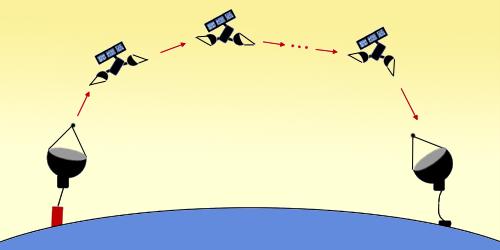Our products Armos(QKD) and Tropos(QRNG) are now on GeM's portal
We are witnessing the second quantum revolution. We are exploring the possible applications of quantum superposition and quantum entanglement. Quantum communication is one of the important use cases of quantum mechanics. Building a large and fully functional quantum network will determine the commercial success of quantum communication.
Though quantum communication has seen significant developments, its progress is hindered due to the limitation of maintaining quantum states of qubits (quantum bits) over large distances.
The world is pacing toward quantum communication as it is considered the safest mode of communication. However, even the best optical fibres or terrestrial free space can carry photons only up to a few hundred kilometres before light absorption makes the process impossible.
Quantum satellites set up for intra and inter-continental quantum cryptography services secure data communication at distances of thousands of kilometres.
Long-distance communication is far more important in meeting the security threat posed by quantum computers, for government, military, as well as business infrastructure. Satellite-based QKD systems offer the best approach for establishing a global-scale quantum network by using satellites that distribute secure keys to ground stations via free-space optical links.
The technology has developed further and a team of researchers in the USA and Canada have shown how quantum information could be relayed over large distances by a network of such satellites.
The Satellite Train
The arrangement uses a train of satellites in low-Earth orbit (LEO). The satellites are equipped with a pair of reflecting telescopes. Each satellite receives a photonic qubit using one telescope and transmits the qubit onward using the other. The satellite train would effectively bend photons around Earth’s curvature while controlling photon loss due to beam divergence. The team says that the arrangement is like a set of lenses on an optical table.
Simulations of satellites 120 kilometres apart with 60-cm-diameter telescopes showed that beam-divergence loss vanished. Over a distance of 20,000 kilometres, total losses—primarily reflection loss but also alignment and focusing errors—could be reduced to orders of magnitude less than those of a few hundred kilometres of optical fibre. Ultrahigh-reflectivity telescope mirrors could further decrease this loss.

S. Goswami/University of Calgary
Making quantum repeaters redundant
The team also proposed an all-satellite quantum network (ASQN). One of the approaches proposed is the “qubit transmission” protocol, in which quantum bits (qubits) are sent from a ground station to the first satellite, transmitted across the chain, and finally beamed down to a second, distant ground station. Such a system would require a different kind of optical design, to counteract the impact of turbulence on the satellite uplink.
The researchers believe that dispensing the need for quantum repeaters or memory with their proposed setups could open a range of possibilities required for a quantum network. The possibilities include secure communication using quantum key distribution (QKD), the linking of quantum computers, and precision long-distance quantum sensing.
The researchers warn that a more complex network—that is, the long-term vision of a ‘quantum internet’ worked on in a variety of research labs—would require some form of quantum memory to ensure completely lossless transmission.
The research could pave the way for the development of globally secure quantum communications networks, as the use of satellites would provide a high level of security against hacking and eavesdropping. Though the proposed system needs further development and testing, it presents a promising solution for enabling long-distance quantum communication without the need for repeaters.
Secure Communication using Quantum Key Distribution (QKD)
A satellite-based QKD system will ensure security over national and international distances, at a cost, much lower compared to ground-based fibre infrastructure for quantum communications.
By ensuring the secure distribution of cryptographic keys over globe-spanning distances, this space-based technology delivers ultra-secure, long-range communications capability at a level that cannot be achieved with ground-based fibre infrastructure.
A global QKD network of ground stations and satellites provides a great platform for securely connecting the world.
Sources
